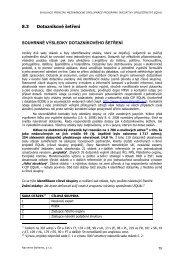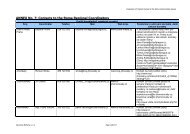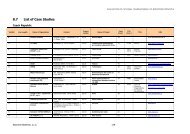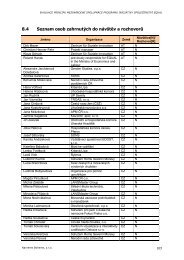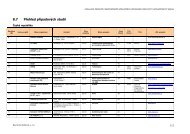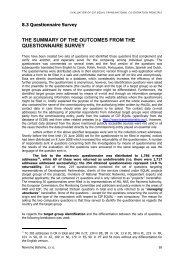EQUAL - Final report - eng - navreme
EQUAL - Final report - eng - navreme
EQUAL - Final report - eng - navreme
Create successful ePaper yourself
Turn your PDF publications into a flip-book with our unique Google optimized e-Paper software.
8.3 Questionnaire Survey<br />
EVALUATION OF CIP <strong>EQUAL</strong> TRANSNATIONAL CO-OPERATION PRINCIPLE<br />
THE SUMMARY OF THE OUTCOMES FROM THE<br />
QUESTIONNAIRE SURVEY<br />
There have been created two sets of questions and identified those questions that complement and<br />
verify one another, and especially serve for the comparing among individual groups. The<br />
questionnaire was commented on several times and the final version of the questions was<br />
subsequently translated from English to Czech, Polish, French, Portuguese, Italian, Spanish and Dutch.<br />
The questionnaires were distributed solely in their electronic version through a web application which<br />
enables a form to be filled in a safe and comfortable manner and sent off on-line and anonymously.<br />
Data are directly downloaded to a database, which considerably increases the efficiency of their<br />
further processing. The questionnaire is anonymous, however, two identification questions were asked<br />
in the preamble to the questionnaire (the country of origin and the type of a target group) so as the<br />
target groups addressed by means of the questionnaire might be differentiated. Furthermore, the<br />
identified target groups were addressed by means of e-mail and through an information campaign<br />
with an accompanying information message containing the website address where the questionnaire<br />
might be filled in, briefly explained the purpose of the questionnaire and the whole evaluation, and<br />
also contained the name of the commissioning entity, the authorizing letter written by MoLSA, and the<br />
contact data in case there should arise any questions to be asked. The contact data (e-mail<br />
addresses) for the addressing of potential respondents from individual target groups were obtained<br />
partly from the commissioning entity, partly from the website of CIP <strong>EQUAL</strong> (specifically from the<br />
database of ECDB) and from other related websites (e.g. http://www.transnationality.eu/). However,<br />
the contact data obtained from the above mentioned publicly accessible sources were not valid in all<br />
the cases therefore the data provided directly by the commissioning entity played an essential role.<br />
Letters written in the above specified languages were sent to the collected contact addresses.<br />
Shortly before the time limit (15 June 2008) set for the questionnaire to be filled in expired, notices<br />
had been distributed on 8 June 2008 which increased the returnability of the questionnaire. A number<br />
of respondents sent in questions concerning both the investigations by means of questionnaires and<br />
the results of the evaluation. All the questions were answered in the same language as was the<br />
language of the question sent in.<br />
The link to the electronic questionnaire was distributed to 1,786 e-mail<br />
addresses 11 , while 69 of these were returned as undeliverable (i.e. there were 1,717<br />
addresses addressed successfully); the 254 obtained questionnaires represent 14.8 %<br />
returnability. Out of these, 219 questionnaires contained the set of questions targeting<br />
representatives of Development Partnerships, clients of the services created under <strong>EQUAL</strong> projects<br />
(target groups of the projects), members of National Thematic Networks, independent experts and<br />
potential applicants; the set contained 21 questions and is only referred to as “projects” hereinafter.<br />
The remaining 35 questionnaires were filled in by representatives of MA, NSS, the Payment Authority,<br />
the European Commission, the Monitoring Committee and politicians and policy-makers in the areas of<br />
HRD and ESF; the set contained thirteen questions in total and is only referred to as “managing<br />
structures” hereinafter. None of the questions – except for the questions concerning the country of<br />
origin and the type of the respondent with respect to CIP <strong>EQUAL</strong> – was compulsory. The reason for<br />
asking the two compulsory questions is that they served to identify the questionnaire as regards the<br />
country and the target group.<br />
As regards the target group identification and the differentiation between the sets of questions,<br />
the following breakdown was used:<br />
11 To 302 addresses in CR in total and 346 in IT, 134 in DE, 98 in UK, 13 in IE, 98 in PL, 219 in FR,<br />
101 in SK, 43 in AT, 109 in NL, 179 in ES, 90 in PT and 54 more without any differentiation for<br />
the English version.<br />
Navreme Boheme, s.r.o. 65



